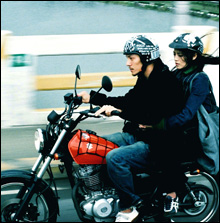 Of the world’s great directors, Taiwan’s Hou Hsiao-Hsien is one of the most obscure. Not just in his lack of recognition, but in the detachment and obliqueness with which he treats the subjects of his films: transience, love, politics, death, and memory. He is also the most Proustian of filmmakers, and such quasi-autobiographical earlier films as Dust in the Wind (1986) and A Time To Live and a Time To Die (1985) draw on the pathos, the details, and the meditative rhythms of lost time recovered.
Of the world’s great directors, Taiwan’s Hou Hsiao-Hsien is one of the most obscure. Not just in his lack of recognition, but in the detachment and obliqueness with which he treats the subjects of his films: transience, love, politics, death, and memory. He is also the most Proustian of filmmakers, and such quasi-autobiographical earlier films as Dust in the Wind (1986) and A Time To Live and a Time To Die (1985) draw on the pathos, the details, and the meditative rhythms of lost time recovered.
Many of his recent films focus on the moment and its broken connections. The impressionistic anti-narratives of Café Lumière and Goodbye, South, Goodbye don’t do much to clear up Hou’s obscurity in either sense of the word. Neither will Three Times. But it does unite his themes of the recalled past and the scattered present, and it may be his most profound, if enigmatic, film to date.
Two lovers, played by same two actors (Shu Qi and Chang Chen), meet inconclusively in three different time periods. Alluding perhaps to his 1985 opus, Hou begins each episode’s title with “A Time for . . . ” Set in 1967, “A Time for Love” might be the most upbeat. A young man (Chang) about to serve his military obligation meets a young woman (Shu) working in a pool hall. He sends her a couple of letters; when he returns to the joint while on leave, he finds she’s moved on to another establishment. Not without difficulty, he tracks her down. Hou shoots these scenes askance and elliptically, with recurrent details like a door or a window opening into the light. In the end, the couple wait for the bus that will take him back to his base; a close-up shows their hands inching closer, touching.
Mission accomplished, though the few strings of banal dialogue hardly presage the happy outcome. As in the other two chapters, Hou slyly eyes the period’s modes of communication, and failure thereof. Here pop songs, letters, and train schedules get the job done.
In “A Time for Freedom,” which is set in 1911, the prospects are dim. Chang plays a wealthy man who patronizes Shu’s courtesan, a house of pleasure replacing the pool hall. She needs him more than the other way around, and while off working for Taiwanese independence from Japanese rule, he fails to confront the more immediate need of his lover’s liberation from her servitude. The most static and stilted segment of the film (it’s shot as a silent movie with title cards), “A Time for Freedom” is also the most beautiful, recalling the stifling opulence of Hou’s Flowers of Shanghai (1998).
ADVERTISEMENT
 |
Finally, after nearly a century, the two get it on in “A Time for Youth.” Not that this time brings them any closer. In the cold blue decadence of Taipei in 2005, he’s an aspiring photographer and she’s an epileptic rock singer with a Yen sign carved in her throat. The means of communicating, scant in the previous two incarnations, now overwhelm the screen, which is often filled with close-ups of e-mails and text messages that relay despairing adolescent song lyrics and screeds choked with despair and self-loathing. The messages drown out any contact. The third time is not the charm, but “Youth” is a work in progress. Having mastered the past, Hou must now confront the present.